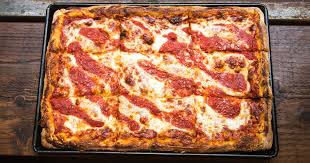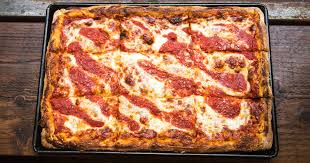Sicilian pizza is a beloved style of pizza that originated in Sicily, Italy. It is characterized by its thick and fluffy crust, which is typically topped with tomato sauce, cheese, and other delicious ingredients. In this article, we’ll delve into the history and origins of Sicilian pizza, explore the different types, and provide you with a recipe and tips for preparing your own mouth-watering Pizza.
Origins and History
This Pizza has a rich history that dates back to ancient times. The ancient Greeks are believed to have introduced the idea of flatbreads with toppings to Sicily, which eventually evolved into modern-day pizza. In fact, the word “pizza” is believed to have originated from the ancient Greek word “pitta,” which referred to a type of flatbread.
Over time, it has developed into its own unique style, with a thick and fluffy crust that is often topped with tomato sauce, cheese, and other ingredients. This style of pizza became especially popular in Sicily in the 19th century when street vendors would sell large rectangular slices of pizza that could be folded and eaten on the go.
Everything About Sicilian Pizza
This is known for its thick, spongy crust that is crispy on the outside and soft on the inside. It is typically rectangular in shape and can be found in a variety of sizes. The toppings are often hearty and plentiful, making it a filling meal on its own.
The crust is typically made with bread flour, water, yeast, olive oil, and salt, and is left to rise for several hours to create its unique texture. The toppings on this pizza can vary, but usually include tomato sauce, mozzarella cheese, and a variety of meats and vegetables. Some popular toppings include pepperoni, sausage, mushrooms, onions, and bell peppers.
How to Prepare Sicilian Pizza
To make this pizza, you’ll need a few key ingredients, including flour, yeast, water, salt, olive oil, tomatoes, cheese, and toppings of your choice. The dough is typically made by mixing flour, yeast, water, salt, and olive oil, then letting it rise for several hours. Once the dough has risen, it is pressed into a well-oiled baking pan and topped with tomato sauce, cheese, and toppings. The pizza is then baked in a preheated oven for about 20-30 minutes until the crust is golden brown and the cheese is melted.
Ingredients and Spices
The ingredients used are similar to those used in other pizza styles, but there are a few key differences. The dough is made with high protein flour, which gives it its distinctive texture. The sauce is typically made with San Marzano tomatoes, a type of plum tomato that is known for its sweetness and low acidity. The cheese used for this is often mozzarella, but other cheeses like provolone and pecorino romano can be used as well. The toppings are typically hearty and plentiful, such as sausage, peppers, onions, and mushrooms.
Health Benefits and Nutritional Values
It is a hearty meal that can provide a variety of nutrients, depending on the toppings used. The crust is typically high in carbohydrates, while the cheese provides protein and calcium. The tomato sauce is a good source of vitamin C and antioxidants. However, because of its thick crust and heavy toppings, this can also be high in calories and fat. It’s best to enjoy in moderation as part of a balanced diet.
What to Eat Sicilian Pizza With
This is a filling meal on its own, but it can also be paired with a variety of side dishes. A fresh salad or antipasto platter can help balance out the richness of the pizza. Garlic bread or breadsticks also make a great addition to a meal. A glass of red wine or a cold beer can also be a nice accompaniment.
Types of Sicilian Pizza
There are several different types, each with its own unique characteristics and flavors. One of the most popular is the traditional Sicilian pizza, which features a thick and fluffy crust that is crispy on the outside and soft on the inside. This type of pizza is typically topped with tomato sauce, cheese, and other ingredients such as sausage, peppers, onions, and olives.
Sicilian Pizza Recipe
Ingredients:
- 4 cups bread flour
- 1 tbsp. instant yeast
- 1 tbsp. salt
- 2 tbsp. extra-virgin olive oil
- 1 1/2 cups warm water (105-115°F)
- 1 lb. can crushed tomatoes
- 1 tsp. dried oregano
- 1/2 tsp. garlic powder
- 1/2 tsp. onion powder
- 1/2 tsp. salt
- 1/4 tsp. black pepper
- 1/4 cup grated Parmesan cheese
- 1/2 lb. shredded mozzarella cheese
Instructions:
- In a large bowl, combine the flour, yeast, and salt.
- Add the olive oil and water, and mix until the dough comes together.
- Turn the dough out onto a floured surface and knead for 8-10 minutes.
- Place the dough in a greased bowl, cover, and let rise in a warm place for 1 hour.
- Preheat the oven to 450°F.
- Grease a 13×9 inch baking pan with olive oil.
- Spread the dough into the prepared pan.
- In a medium bowl, mix together the crushed tomatoes, oregano, garlic powder, onion powder, salt, and black pepper.
- Spread the tomato sauce over the dough, leaving a small border around the edges.
- Sprinkle the Parmesan cheese over the tomato sauce.
- Add the shredded mozzarella cheese on top of the Parmesan cheese.
- Bake for 25-30 minutes, until the cheese is melted and bubbly and the crust is golden brown.
- Let the pizza cool for a few minutes before slicing and serving.

Frequently Asked Questions
- What is the difference between Sicilian pizza and other types of pizza?
It is thicker and has a spongier crust compared to other types of pizza. It is also square-shaped with a crispy crust, and it is usually topped with tomato sauce, cheese, and other ingredients.
- What are the typical toppings for Sicilian pizza?
Sicilian pizza can be topped with a variety of ingredients, but the most common toppings are tomato sauce, mozzarella cheese, oregano, and olive oil. Other toppings may include onions, peppers, mushrooms, sausage, pepperoni, and anchovies.
- How do you make the dough for Sicilian pizza?
The dough for Sicilian pizza is made using flour, yeast, water, salt, and sugar. It is then kneaded for several minutes until it is smooth and elastic. The dough is then left to rise for several hours before it is rolled out and placed in a pan.
More Info
- What is the nutritional value of Sicilian pizza?
The nutritional value of Sicilian pizza varies depending on the toppings used, but it is generally high in calories, fat, and sodium. It may also contain a moderate amount of protein and fiber.
- Can Sicilian pizza be frozen?
Yes, Sicilian pizza can be frozen for later use. Once it has been cooked, allow it to cool completely before wrapping it tightly in plastic wrap and placing it in the freezer. When ready to eat, simply thaw the pizza in the refrigerator overnight and reheat it in the oven.
- What should I serve with Sicilian pizza?
Sicilian pizza pairs well with a variety of side dishes, including salads, garlic bread, and pasta dishes. It is also commonly served with a variety of beverages, such as beer, wine, and soda.
- What is the origin of Sicilian pizza?
Sicilian pizza originated in Sicily, Italy, in the 17th century. It was traditionally made with ingredients that were readily available in the region, such as tomatoes, cheese, and olive oil. Today, it is enjoyed all over the world and has become a popular variation of traditional pizza.
- What is the difference between Sicilian pizza and Chicago-style deep-dish pizza?
Sicilian pizza and Chicago-style deep-dish pizza are both thick-crust pizzas, but they differ in their crust texture and shape. Sicilian pizza has a spongy crust and is typically square-shaped, while Chicago-style deep-dish pizza has a flaky, buttery crust and is typically round-shaped.
Conclusion
Sicilian pizza is a beloved style of pizza that originated in Sicily, Italy. It is known for its thick, fluffy crust and generous toppings. There are many variations of Sicilian pizza, but the classic version typically features a tomato sauce, cheese, and toppings like onions, peppers, and sausage. With its delicious flavor and hearty texture, Sicilian pizza is a favorite among pizza lovers all over the world. So why not try making your own Sicilian pizza at home using the recipe provided above? You won’t be disappointed!

